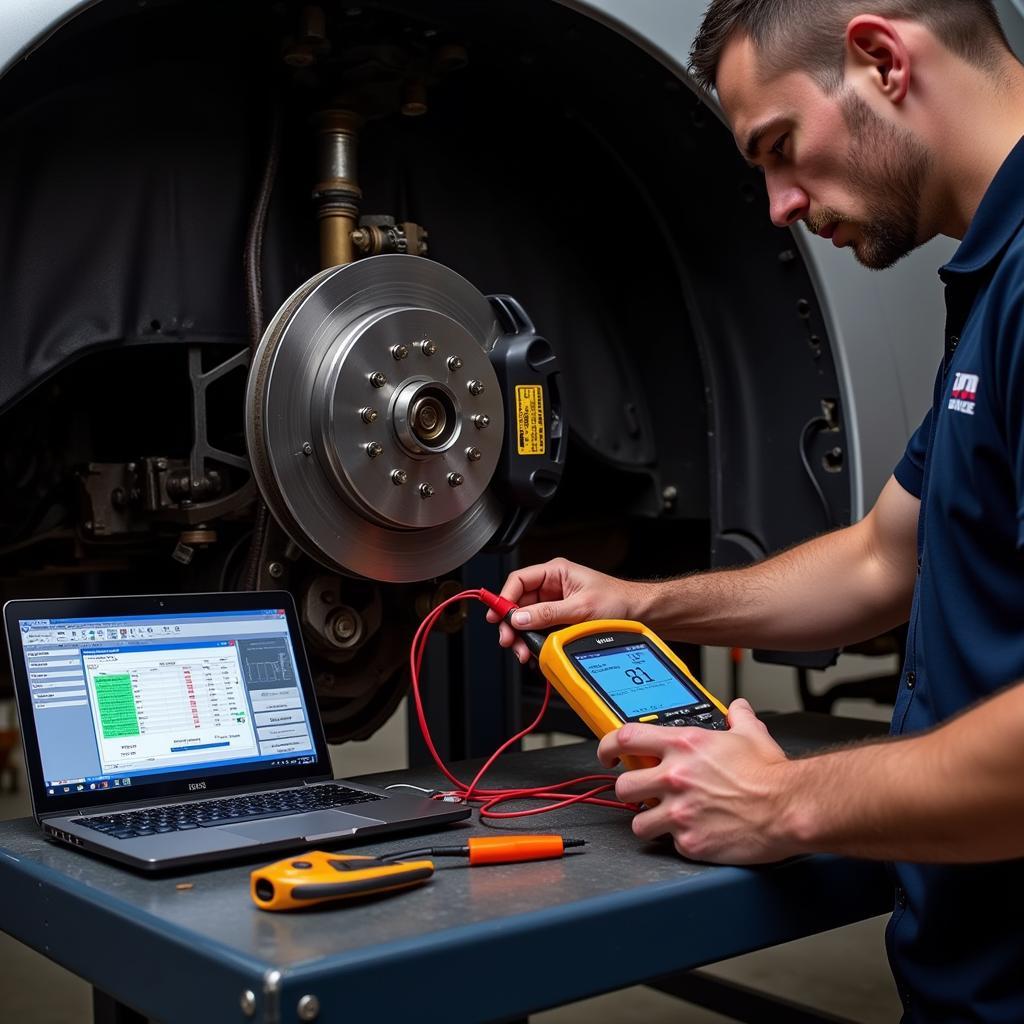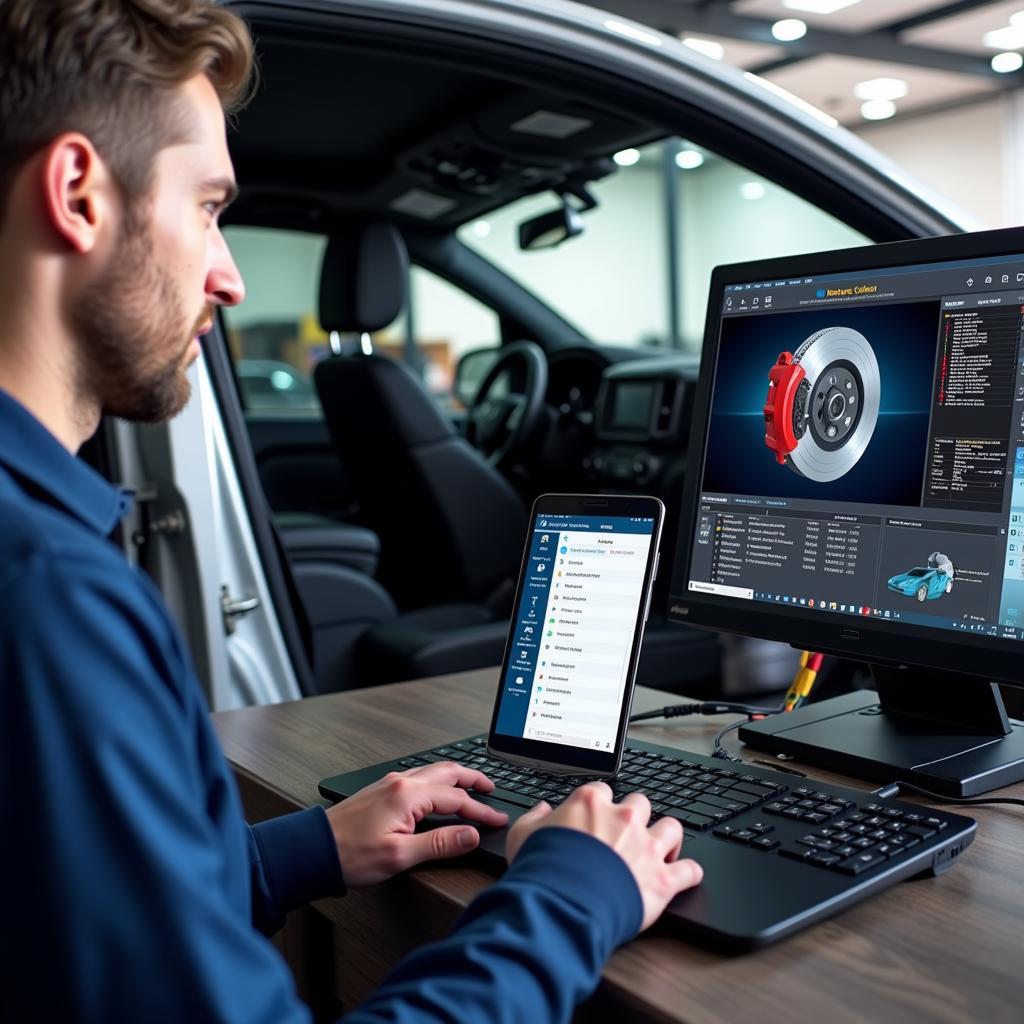Warner Electric brakes are a crucial component of many vehicles, ensuring safe and reliable stopping power. However, like any complex system, they can sometimes experience issues. This comprehensive guide will delve into common problems with Warner Electric brakes, outlining diagnostic procedures and exploring how remote services can provide efficient solutions.
Understanding Warner Electric Brake Systems
Before diving into troubleshooting, it’s beneficial to grasp the fundamentals of Warner Electric brake systems. Unlike traditional hydraulic brakes, these systems utilize electromagnetic forces to generate braking torque. A typical setup involves an electromagnetic coil within the brake drum, a friction disc, and an armature plate. When the driver applies the brakes, the electromagnetic coil energizes, attracting the armature plate and pressing the friction disc against the drum to create braking force.
Common Issues with Warner Electric Brakes
A range of factors can lead to problems in Warner Electric brake systems, from electrical faults to mechanical wear and tear. Some common issues include:
- Insufficient braking power: This can manifest as a soft or spongy brake pedal, increased stopping distances, or even complete brake failure. Causes may include worn brake linings, air in the system, or a malfunctioning electromagnetic coil.
- Dragging brakes: This occurs when the brakes don’t release fully, resulting in decreased fuel efficiency, premature wear on brake components, and potential overheating. Dragging can be caused by issues such as a misadjusted actuator, a seized caliper, or problems with the brake control module.
- Noisy brakes: Squealing, grinding, or scraping noises during braking often indicate a problem with the brake shoes, drums, or other components. Worn brake linings are a frequent culprit, but debris or foreign objects lodged in the brake assembly can also cause noise.
Diagnosing Warner Electric Brake Problems
 Warner Electric Brake Diagnostics
Warner Electric Brake Diagnostics
Accurately diagnosing the root cause of a brake problem is crucial for implementing the correct repair. Here’s a general approach to diagnosing Warner Electric brake issues:
- Visual Inspection: Begin by visually inspecting the entire brake system, including the wiring, connectors, brake drums, and brake linings. Look for signs of physical damage, wear, corrosion, or loose connections.
- Diagnostic Tools: Modern vehicles come equipped with onboard diagnostic (OBD) systems. Connecting a scan tool to the OBD-II port can reveal valuable information about the brake system’s status, including error codes related to sensors, actuators, or the control module.
- Manual Tests: Depending on the suspected issue, you may need to perform manual tests such as measuring voltage at the brake magnet, checking the resistance of the brake coil, or inspecting the brake linings for wear.
The Role of Remote Diagnostics and Programming
 Remote Diagnostics for Warner Electric Brakes
Remote Diagnostics for Warner Electric Brakes
Advancements in automotive technology have paved the way for remote diagnostics and programming, offering significant advantages in addressing Warner Electric brake issues:
- Rapid Diagnosis: Connecting to the vehicle remotely allows technicians to read error codes, analyze live data streams from the brake system, and pinpoint the faulty component quickly, often without needing an in-person visit.
- Software Updates: In some cases, issues with Warner Electric brakes stem from software glitches within the brake control module. Remote programming allows technicians to upload the latest software versions to the module, potentially resolving the problem without physically accessing the vehicle.
- Reduced Downtime: Remote diagnostics can significantly reduce vehicle downtime by quickly identifying the issue and determining if a mobile repair or a visit to a repair facility is necessary.
The Future of Warner Electric Brake Service
As vehicles become increasingly connected, remote services are poised to play an even greater role in diagnosing, maintaining, and repairing Warner Electric brakes.
“The ability to diagnose and address brake issues remotely is a game-changer,” says John Smith, Senior Automotive Engineer at [Your Company Name]. “This technology not only saves time and money for vehicle owners but also allows us to address issues proactively, enhancing safety on the road.”
Conclusion
Warner Electric brakes are a testament to innovation in braking technology, offering numerous advantages in various automotive applications. Understanding how these systems work, recognizing potential problems, and leveraging remote diagnostics and programming will be crucial for keeping these advanced braking systems operating safely and efficiently in the years to come.
FAQs
1. How often should I have my Warner Electric brakes serviced?
It’s generally recommended to have your Warner Electric brakes inspected annually or as part of your vehicle’s regular maintenance schedule. However, if you notice any unusual symptoms like noise, vibration, or changes in braking performance, seek immediate professional inspection.
2. Can I work on my Warner Electric brakes myself?
While a visual inspection can be done by most vehicle owners, diagnosing and repairing Warner Electric brake systems often requires specialized knowledge, tools, and equipment. It’s always safest to consult a qualified mechanic, especially for complex issues.
3. Are Warner Electric brakes compatible with all vehicles?
Warner Electric brakes are commonly found on trailers, RVs, and some commercial vehicles. However, they are not universally compatible with all vehicles. Consulting your vehicle manufacturer’s specifications is essential to determine compatibility.
4. What is a Warner Electric magnetic brake?
A Warner Electric magnetic brake is a type of braking system that utilizes an electromagnet to generate braking force. Warner electric magnetic brake offer numerous advantages over traditional hydraulic brakes, including increased stopping power, faster response times, and reduced maintenance requirements.
5. What is the difference between a Warner Electric magnetic brake and a Warner electric magnetic particle brake?
While both use electromagnetism, a Warner electric magnetic particle brake uses magnetic particles in a dry gap to create friction and braking force, offering smoother engagement and more precise control compared to traditional magnetic brakes.
6. Where can I find a Warner Electric brake service manual?
Service manuals provide valuable information about your specific brake system. You can often find Warner Electric brake service manual online from reputable sources or directly from the manufacturer.
7. Can remote diagnostics fix all Warner Electric brake problems?
While remote diagnostics is a powerful tool, it cannot fix all problems. Some issues may still require hands-on repairs or component replacement that cannot be addressed remotely. However, remote diagnostics can often pinpoint the issue and determine the necessary course of action, saving time and potentially avoiding unnecessary repairs.
